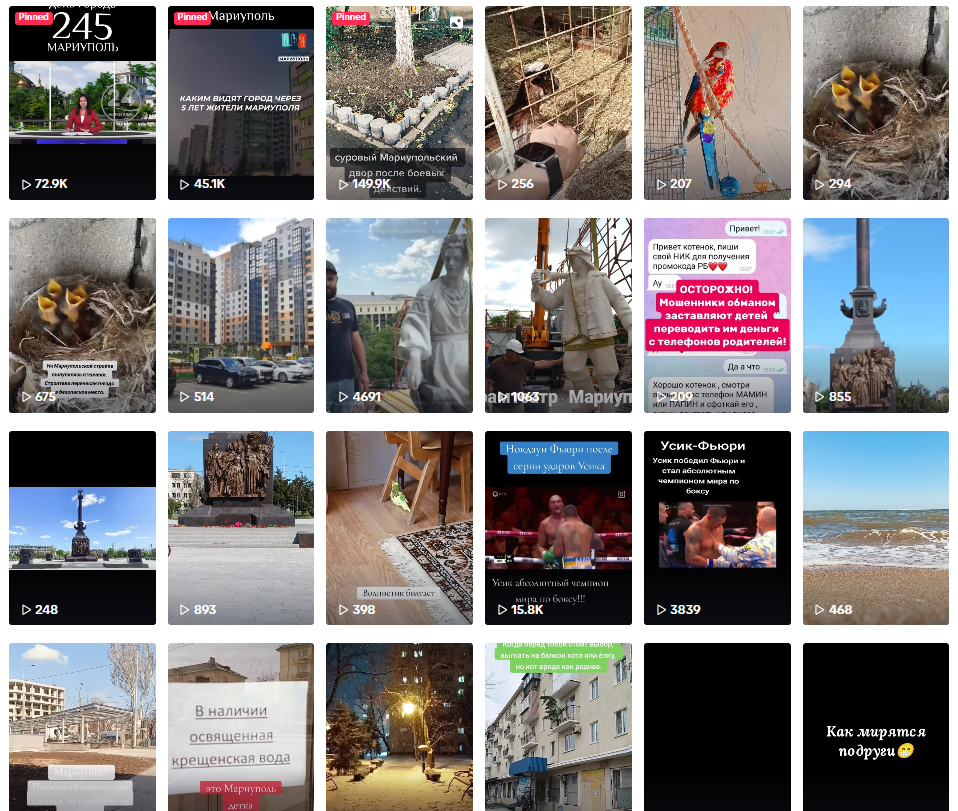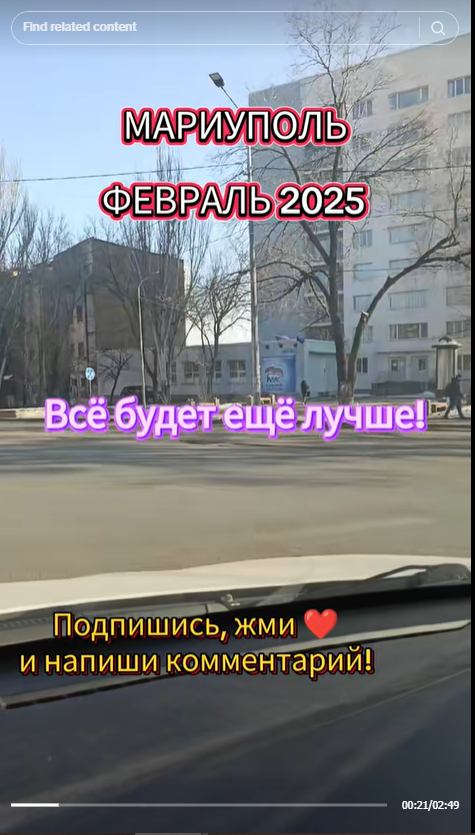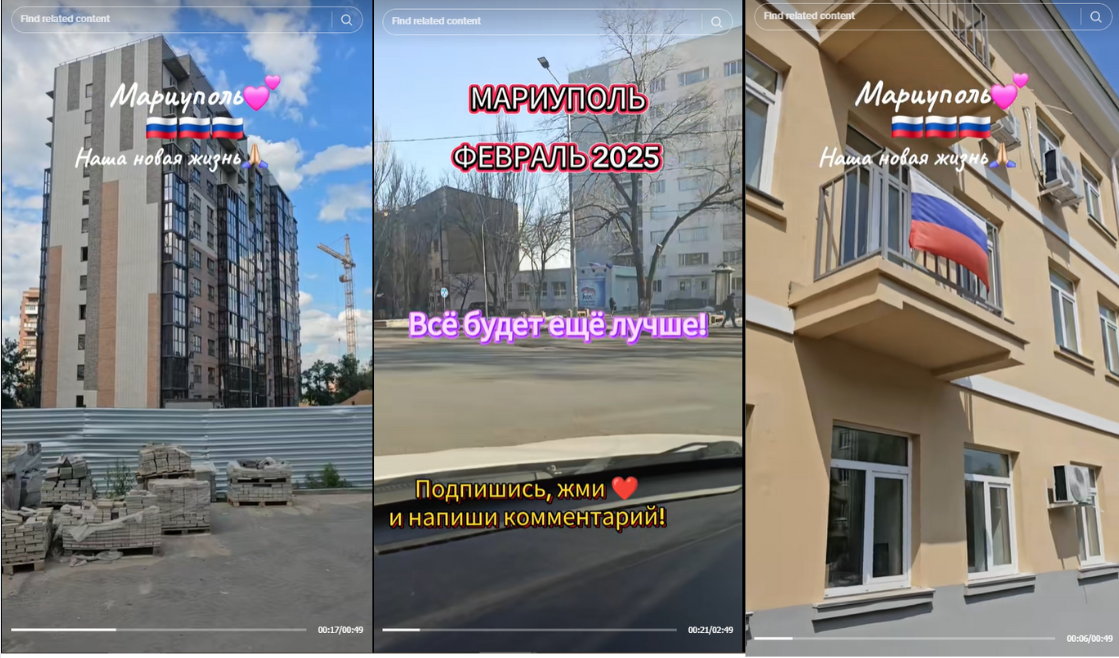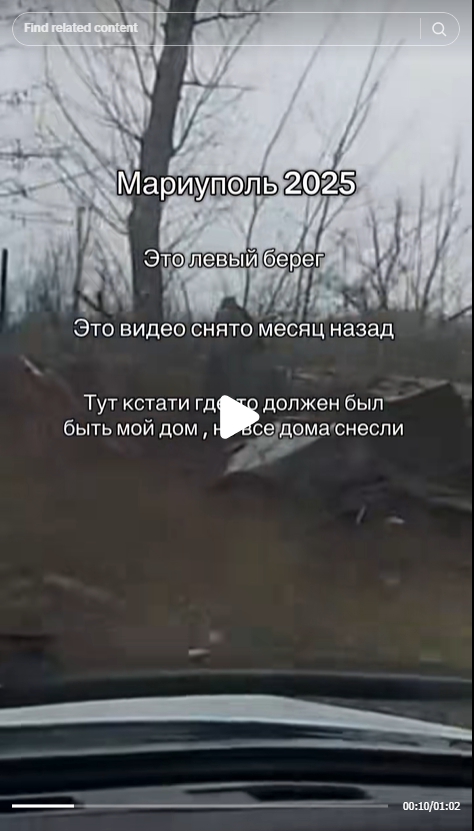Manufacturing reality: How pro-Russian TikTok accounts promote Donbas’s revival
On TikTok, pro-Russian accounts are attempting to craft an image of a thriving Mariupol, despite concerns from citizens on the ground.
Manufacturing reality: How pro-Russian TikTok accounts promote Donbas’s revival
Share this story

BANNER: A TikTok profile dedicated to showing reconstructed locations in Mariupol and the Donetsk People’s Republic. (Source: @ourmariupol)
The ongoing Russian occupation of Ukrainian regions raises concerns about Russia’s strategy to socially and culturally integrate the population in the occupied territories. The DFRLab and OpenMinds recently published a report, Digital occupation: Pro-Russian bot networks target Ukraine’s occupied territories on Telegram, which examines how integration is promoted and supported by Telegram bot comments that manufacture public acceptance of Russia and the occupation, while seeking to create distrust towards the Ukrainian government.
Similar behavior is also unfolding on other platforms, albeit tailored to each platform’s infrastructure. On TikTok, for instance, pro-Russian actors capitalize on the platform’s audiovisual features. Videos that pan through allegedly rebuilt cities in occupied eastern and southern Ukraine rely on the power of visual persuasion—after all, seeing is believing. TikTok’s preference for direct-to-camera influencer-style content has also been repurposed to promote Russian narratives. In 2024, an organization tied to the Kremlin, the Donbass Mediacenter, launched a specialized school for bloggers, specifically targeting influencers operating in the occupied territories. These schools help new creators develop skills to establish an audience while ensuring their content reflects the Kremlin’s messaging on key topics. The practice of using influencers local to the occupied territories to reach a more niche audience is not new; Russia has used Instagram and YouTube to advertise the alleged benefits of life in the Donetsk and Luhansk People’s Republic since the initial occupation in 2014.
Many of these influencers have since evolved into established personalities, developing distinct content styles, securing commercial brand partnerships, and building relations with local governments and fan bases, or, alternatively, with “haters” who watch and comment to expose the falsehoods. Individuals like Pavel Karbovsky, or Donbass Kosmonavt, have managed to carve out a niche promoting the alleged prosperity in the occupied region. Notably, TikTok bloggers like Karbovsky have previously found themselves banned from the platform. Additionally, some of these influencers will also establish advertising partnerships with local businesses. The content mix of business reviews and everyday vlogging creates an organic environment from which to push narratives about the successful rebuilding of Donbas. These local influencers serve the Kremlin’s goal of establishing a picture of a rapidly developing and flourishing region.
Following the Russian army’s occupation of Mariupol and the establishment of an occupation administration, an ecosystem of influencers emerged in the city. Their videos promote the idea that the city is undergoing a successful renovation, that the quality of life is significantly higher than it was under Ukrainian management, and that the Russian government and the newly established local administrations are responsible for this improvement. These TikTok narratives align with the findings of the DFRLab and OpenMinds in their analysis of Telegram narratives, which aim to portray a positive image of life under occupation while undermining the Ukrainian government. On TikTok, this content looks like extensive drives or walkthroughs of the city, showcasing areas of Mariupol that appear to have been superficially restored, or day-in-the-life vlogs celebrating the “liberation from Ukraine.” Some channels are dedicated solely to posting content depicting the alleged successful rebuilding of Mariupol, while others integrate similar content among other personal or generic videos. Both the niche and personal accounts tend to have usernames that refer to their current locations, featuring names of cities and towns, often in the Donetsk and Luhansk regions, with Mariupol being a prominent example.


Niche accounts dedicated to a particular type of content are not a rare phenomenon on TikTok, with many social media marketing agencies and creators on the platform advising new users to consistently focus on a single topic to grow an audience. The tours of Mariupol tend to display similar editing styles and focus on a specific lineup of locations that appear to have been selected for their presentability. The video creators actively request engagement from viewers within the thumbnails and videos themselves through prompts for likes and comments. Authors of these videos tend to favor bold lettering and bright fonts. They will occasionally insert sarcastic remarks about how “there are no people or cars, the occupants are not letting us live,” referring to Ukrainian and Western reports about the state of the infrastructure in Mariupol.

As the occupation of the once industrial center of Mariupol enters its fourth year, the city has sustained significant damage and ruination during the initial Russian offensive, and it is currently unclear how much of it has genuinely recovered. During the height of the fighting around Mariupol in 2022, close to 90 percent of the apartment buildings and objects of key infrastructure, such as hospitals and higher education institutions in Mariupol, were destroyed or damaged, according to Human Rights Watch estimates. Witness accounts discussed a lack of housing or functional utilities, and the political persecution of those associated with unoccupied Ukraine or displaying dissenting opinions. Petro Andriushchenko, advisor to the mayor of Mariupol, noted that within the last three years, the occupying administration had cleared rubble and demolished unsound buildings, but, while some clean-up occurred, many citizens who lost their homes remained without permanent housing, as the clean-up reportedly was not followed up by reconstruction of apartment building blocks. Locals have stated that there is a belief that many of the changes in the city were implemented to facilitate the filming of propaganda material.
The issue of reconstruction is of crucial importance to locals, both those still on the ground and those who have been forced to evacuate since the start of the full-scale invasion. Some TikTok accounts covering Mariupol and promoting Russian narratives exploit this by showcasing the active construction of new apartment buildings, the reconstruction of churches or other culturally significant buildings, and prominently featuring the clean areas of the city adorned with Russian flags and coat of arms.

There has been limited public access to the on-the-ground situation in Mariupol, and Google Earth satellite images have not been updated since 2023. Ukrainian and Western media outlets have reported on the reconstruction efforts, noting that much of the city remains in ruins, but any messaging disparaging Russia is seen as suspicious by those with pro-Russian tendencies. Even among those who support Ukraine, anonymized witness testimonies can carry less evidentiary weight than satellite images or video documentation. Providing a systematic account of the current state of infrastructure in Mariupol, featuring ample evidence and unbiased assessment, is currently not possible, as even if international organizations were allowed into the city, the scope of their work would likely be highly limited by what the occupying government would permit them to see.
Occasionally, other accounts on TikTok showcase parts of the city not typically featured in propagandist content, painting a picture of destruction and a lack of progress in reconstruction. These accounts, however, are few and far between, due to a fear of surveillance and punishment.

At times, however, even the propagandist accounts and videos contradict themselves, accidentally showing damaged and abandoned buildings in the background while showcasing the newest public square. However, these occasional glimpses are insufficient to counterbalance the generally positive perception promoted in most of the videos, as the destruction is often only visible if one is looking for it.

Russia, through its complex system of control over the information environment in the occupied territories, which includes local micro influencers, actively makes use of this environment of uncertainty, promoting the publication of multiple videos showing the image of Mariupol it wishes to be out there in the world and capitalizing on the fact that these are some of the only photos and videos available to the average user. Additionally, this content crowds out any videos showing the less curated parts of town, which are not yet reconstructed or have been entirely abandoned due to excessive damage. For those already skeptical of the Ukrainian government or sympathetic to Russia, such content may solidify existing biases. For more neutral observers, it could introduce the initial seed of skepticism.
Cite this case study:
Iryna Adam, “Manufacturing reality: How pro-Russian TikTok accounts promote narratives about Donbas’s revival” Digital Forensic Research Lab (DFRLab), July 21, 2025, https://dfrlab.org/2025/07/21/manufacturing-reality-how-pro-russian-tiktok-accounts-promote-narratives-about-donbas-revival/.

